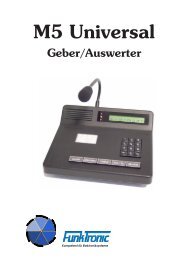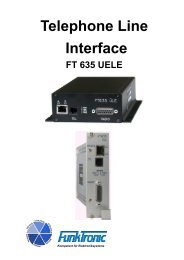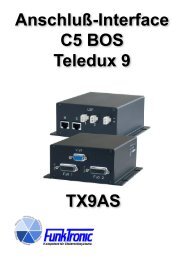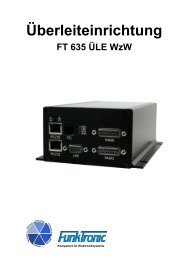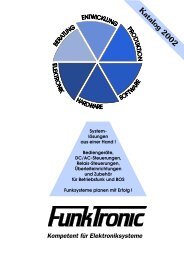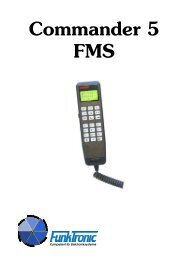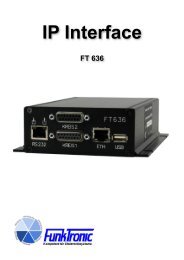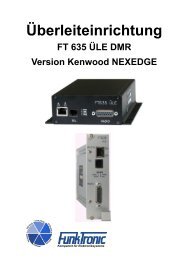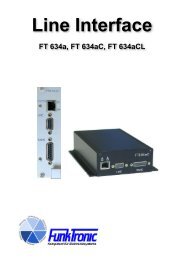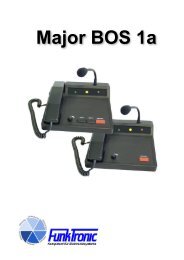Sample configurations Major 4a - Funktronic
Sample configurations Major 4a - Funktronic
Sample configurations Major 4a - Funktronic
You also want an ePaper? Increase the reach of your titles
YUMPU automatically turns print PDFs into web optimized ePapers that Google loves.
English 3.4<br />
<strong>Major</strong> <strong>4a</strong><br />
No update at all!<br />
See german version version!<br />
Kompetent für Elektroniksysteme
Contents<br />
Order Information 2<br />
Delivery 2<br />
Technical Data 2<br />
Control Elements <strong>Major</strong> <strong>4a</strong> 3<br />
General features 3<br />
Rearview <strong>Major</strong> <strong>4a</strong> 4<br />
Sockets pinout <strong>Major</strong> <strong>4a</strong> 4<br />
Connecting <strong>Major</strong> <strong>4a</strong> (5a) --> Two-Way-Radio via multiwire 5<br />
Connecting <strong>Major</strong> <strong>4a</strong> (5a) --> Line Interface LIM-AC 5<br />
Keypad layout in programming mode 6<br />
Menu structure 6<br />
2-wire confi guration with FT630 9<br />
Hardware confi guration 9<br />
2/4-wire confi guration 9<br />
Software confi guration 10<br />
Programming short call 10<br />
Individual programming of the buttons 11<br />
Loudspeaker button coding 12<br />
Encoder prefi x 13<br />
Transmitting 6/7/8-tone 14<br />
Sequences 14<br />
Channel scanning function 14<br />
Reset to factory defaults 15<br />
<strong>Sample</strong> confi gurations <strong>Major</strong> <strong>4a</strong> (5a) 16<br />
Table of registers <strong>Major</strong> <strong>4a</strong> 17<br />
Function registers for buttons 22<br />
RS232 cable for fl ashing/printing/monitoring 25<br />
Serial interface RS232 25<br />
Release Notes 26<br />
Technical Data<br />
Voltage of operation 12 V<br />
Current max. 800 mA<br />
Weight 1,5 kg<br />
Dimensions (without gooseneck microphone) 245 x 220 x 95 mm<br />
Input impedance 2/4-wire 600 Ohm<br />
Output impedance 2/4-wire 600 Ohm<br />
Order Information<br />
Ord.-No. Description<br />
681000 <strong>Major</strong> <strong>4a</strong><br />
900012 Power Supply 230/12 Volt<br />
Delivery<br />
<strong>Major</strong> <strong>4a</strong> with handset and gooseneck microphone<br />
Power plug<br />
Power Supply not delivert with<br />
Kompetent für Elektroniksysteme<br />
- 2 -<br />
m<strong>4a</strong>_eng (06.12.2005)
Control Elements <strong>Major</strong> <strong>4a</strong><br />
m<strong>4a</strong>_eng (06.12.2005)<br />
Handset<br />
with PTT button<br />
General features<br />
Gooseneck microphone<br />
Status LED´s<br />
Short call button<br />
Call button<br />
Loudspeaker button<br />
- 3 -<br />
PTT button<br />
LC Display<br />
Function buttons<br />
Special buttons<br />
The <strong>Major</strong> <strong>4a</strong> is the newer design of the well-known <strong>Major</strong> 4. An alphanumeric LC Display with<br />
background lighting has replaced the LED Display. A gooseneck microphone with high dynamics is<br />
new. The programming possibilities have been essentially widened and strongly simplifi ed through<br />
a clear text menu structure.<br />
There are two sockets for headsets. One can be used for a remote PTT foot switch. The 7 digital<br />
outputs can be used for remote channel select or for other functions. For operation an external 12volt<br />
power supply is necessary.<br />
The <strong>Major</strong> <strong>4a</strong> can be programmed via the serial interface or keypad. It is also possible to connect a<br />
printer or terminal on the serial interface. For printers with parallel interface an optional interface is<br />
available.<br />
An ISDN interface is on schedule. The main feature is connecting phone calls to the radio and visa<br />
versa. Of course you can use it also as a normal ISDN phone.<br />
Kompetent für Elektroniksysteme
Rearview <strong>Major</strong> <strong>4a</strong><br />
Sockets pinout <strong>Major</strong> <strong>4a</strong><br />
All sockets shown from rear few.<br />
Kompetent für Elektroniksysteme<br />
Pinout Radio socket ST1,<br />
rearview<br />
AF input B 1<br />
AF input A 2<br />
Squelch input 3<br />
GND 4<br />
+12 V, max. 200 mA 5<br />
Transmit active low 6<br />
AF output A 7<br />
AF output B 8<br />
All audio in/outputs equiped with transformers.<br />
PIN 5 is for supply (+12V) of external devices<br />
(LIM-AC, FT634C, FT633AC).<br />
Attention, do not use PIN 5 to supply a radio,<br />
200 mA output current is not suffi cient.<br />
Pinout<br />
RS232 ST4<br />
NC 1<br />
NC 2<br />
TxD 3<br />
RxD 4<br />
GND 5<br />
NC 6<br />
All audio in/outputs equiped with transformers.<br />
ST1 Radio socket ST = socket<br />
ST2 Headset 1<br />
ST2A Headset 2<br />
ST3 Digital outputs<br />
ST4 Serial interface RS232<br />
PWR Power supply 12V, max. 1,5 A<br />
inside positive, outside ground<br />
- 4 -<br />
Pinout headset 1 + 2,<br />
ST2 and ST2A<br />
GND 1<br />
GND ST2, AF mic. ST2A 2<br />
AF earphone 3<br />
GND earphone 4<br />
GND ST2A, AF mic. ST2 5<br />
PTT, active GND 6<br />
There are two sockets for connecting a headset.<br />
One is for connecting headset, the other for use<br />
of external PTT-Button.<br />
Pinout ST3<br />
digital in/outputs<br />
OUT0 1<br />
OUT1 2<br />
OUT2 3<br />
OUT3 4<br />
OUT4 5<br />
OUT5 6<br />
OUT6 7<br />
GND 8<br />
The digital Pin’s can be confi gured as in- or<br />
outputs. Mostly the outputs are used for remote<br />
channel select.<br />
m<strong>4a</strong>_eng (06.12.2005)
Connecting <strong>Major</strong> <strong>4a</strong> (5a) --> Two-Way-Radio via multiwire<br />
All audio in/outputs of the <strong>Major</strong> <strong>4a</strong> (5a) are equipped with transformers. No Pin’s are grounded in the<br />
<strong>Major</strong> <strong>4a</strong> (5a); therefore a connection to ground must be made at the two-way-radio side, preferably<br />
by grounding PIN 1 and 8 to PIN 4.<br />
PIN 5 is for supply (+12V) of external devices (LIM-AC, FT634C, FT633AC).<br />
Attention, do not use PIN 5 to supply a radio, 200 mA output current is not suffi cient.<br />
Connecting <strong>Major</strong> <strong>4a</strong> (5a) --> Line Interface LIM-AC<br />
The line interface LIM-AC is connected to the <strong>Major</strong> <strong>4a</strong> (5a) via an 8-wire (Ethernet) patch cable.<br />
m<strong>4a</strong>_eng (06.12.2005)<br />
- 5 -<br />
Kompetent für Elektroniksysteme
Keypad layout in programming mode<br />
The button reduces by 1 and the button increases by 1.<br />
The buttons S1 to S4, the * button and the # button are related<br />
with A to F.<br />
Menu structure<br />
Simultaneous pressing of the * button and the # button you get into the menu. With the button<br />
the next menu level is reached. With the button the selected menu point is activated.<br />
select number:<br />
* simultaneously #<br />
- enter the register number<br />
to be programmed<br />
- with 222 the factory default<br />
values are programmed<br />
- overwrite the Code with<br />
your values<br />
= escape menu without<br />
change<br />
= store value, escape<br />
menu<br />
Kompetent für Elektroniksysteme<br />
È<br />
EEPROM programming : F4<br />
Next menu : F3<br />
Register:<br />
Register: 000<br />
Code 12345<br />
Software version : F4<br />
Next menu : F3<br />
Æ Æ<br />
È È È<br />
Software: <strong>Major</strong> <strong>4a</strong> V1.24<br />
Date : 23.09.04<br />
- displayed for 3 seconds<br />
- 6 -<br />
-<br />
¡ S1¡ A ¡ S1¡ A<br />
¡123 45 8<br />
0 9 7<br />
*<br />
6<br />
¡<br />
#<br />
A ¡<br />
¡<br />
E F<br />
B ¡ S2¡<br />
¡ C ¡ S3¡ C ¡ S3¡ C ¡<br />
¡ D ¡ S4<br />
¡<br />
1 = Input level<br />
2 = Output level<br />
3 = Gooseneck<br />
microphone level<br />
4 = Handset microphone<br />
level<br />
5 = Headset microphone<br />
level<br />
6 = DTMF output level<br />
- the adjustment area of the<br />
Pots is 0-63<br />
- input direct via the keypad<br />
or<br />
+<br />
Level settings : F4<br />
Next menu : F3<br />
Poti-Nr. (1-6):<br />
= increase value<br />
= reduce value<br />
= escape menu without<br />
change<br />
= store value, escape<br />
menu<br />
m<strong>4a</strong>_eng (06.12.2005)
Menu structure<br />
Continuation<br />
select number:<br />
* simultaneously #<br />
È<br />
0 = 200 Hz<br />
1 = 300 Hz<br />
2 = 400 Hz<br />
3 = 600 Hz<br />
4 = 800 Hz<br />
5 = 1000 Hz<br />
6 = 1600 Hz<br />
7 = 2400 Hz<br />
8 = 3400 Hz<br />
9 = 4000 Hz<br />
S1 = 2900 Hz<br />
S2 = 3000 Hz<br />
S3 = 3100 Hz<br />
S4 = 3300 Hz<br />
* = 1200 Hz<br />
# = 1800 Hz<br />
m<strong>4a</strong>_eng (06.12.2005)<br />
Æ Æ Æ<br />
Transmit test tone : F4<br />
Next menu : F3<br />
È<br />
Change frequency 0.....C<br />
F3 for ESC Hz<br />
= escape menu<br />
Æ<br />
Adjust contrast : F4<br />
Next menu : F3<br />
È<br />
Displaycontrast: 90<br />
F1- F2+ F3ESC F4STORE<br />
= reduce contrast<br />
= increase contrast<br />
= escape menu without<br />
change<br />
= store value, escape<br />
menu<br />
- 7 -<br />
Æ<br />
Set date/time : F4<br />
Next menu : F3<br />
È<br />
15.10.04 22:47:01<br />
= Move one digit left<br />
= Move one digit right<br />
= escape menu without<br />
change<br />
= store value, escape<br />
menu<br />
Enter the required value with<br />
the keypad 0 to 9.<br />
Kompetent für Elektroniksysteme
Menu structure<br />
Continuation<br />
select number:<br />
* simultaneously #<br />
È<br />
Kompetent für Elektroniksysteme<br />
Æ Æ Æ<br />
Æ Æ Æ<br />
Adjust clock : F4<br />
Next menu : F3<br />
È<br />
Digital (0-6) : 3<br />
Analog (00-59): 29<br />
= one digit left<br />
= one digit right<br />
The onboard clock is factory<br />
calibrated.<br />
Before changing the values<br />
please note down the current<br />
values.<br />
High values accelerate and low<br />
values decelerate the clock.<br />
Changes made in digital have<br />
more effect than changes made<br />
in analogue.<br />
Fine adjustment must be done in<br />
analogue, step by step.<br />
= escape menu without<br />
change<br />
= store value, escape<br />
menu<br />
Æ<br />
Serial number : F4<br />
Next menu : F3<br />
È<br />
Serial number: 1111-22<br />
Mainboard : FFFF/FF<br />
- displayed for 3 seconds<br />
- 8 -<br />
m<strong>4a</strong>_eng (06.12.2005)
Hardware confi guration<br />
2/4-wire confi guration<br />
The <strong>Major</strong> <strong>4a</strong> (5a) is for use on 2- or 4-wire line. The confi guration for 2- or 4- wire is done in register<br />
051/4.<br />
2-wire confi guration with FT630<br />
For remote control of radio over longer distance it is adviceable to use a 2-wire line with the FT630.<br />
The FT630 transmits and receives the PTT and SQUELCH status via a DC control voltage.<br />
If there is no DC continuity on the line or if remote channel select is necessary, a FT634C (FT634)<br />
or FT633AC is required.<br />
m<strong>4a</strong>_eng (06.12.2005)<br />
- 9 -<br />
Kompetent für Elektroniksysteme
Software confi guration<br />
Programming short call<br />
The example below shows the programming of<br />
short dial 1 in register 001 with tone sequence<br />
12345.<br />
The line „Code“ shows the current programming.<br />
Overwrite with the requested values.<br />
Kompetent für Elektroniksysteme<br />
select number:<br />
* simultaneously #<br />
È<br />
EEPROM programming : F4<br />
Next menu : F3<br />
Register:<br />
È<br />
0<br />
0<br />
1<br />
È<br />
Register: 001<br />
Code 12345<br />
The line „Code“ shows the current programming.<br />
Overwrite with your values.<br />
Key F3 escapes without any changes.<br />
Key F4 stores the displayed values.<br />
All buttons of the <strong>Major</strong> <strong>4a</strong> can be programmed<br />
with any function. Register 174 and 175 has to<br />
be programmed with the appropriate values of the<br />
short call button (Z-Button).<br />
Register 174 is for use of the functions after short<br />
activation of the Z-Button and register 175 is for<br />
use of the functions after longer activation of the<br />
Z-button.<br />
Register 174 is programmed with 22F01 and<br />
register 175 with 00000.<br />
The fi rst zero in register 175 disables action after<br />
long pressing Z-Button.<br />
- 10 -<br />
The digits in register 174 activate the following<br />
functions:<br />
1. digit = 2 --> function 2 - transmit call<br />
sequence<br />
2. digit = 2 --> short dial<br />
3. digit = F --> input necessary<br />
4. digit = 0 --> 5 tone sequence<br />
5. digit = 1 --> not applicable<br />
Follow the next steps to view or change the values<br />
in register 174 and 175.<br />
select number:<br />
* simultaneously #<br />
È<br />
EEPROM programming : F4<br />
Next menu : F3<br />
Register:<br />
È<br />
1 74<br />
È<br />
Register: 174<br />
Code 12345<br />
È<br />
Register: 174<br />
EEPROM programmed<br />
Register:<br />
È<br />
È<br />
Funk Tronic <strong>Major</strong> <strong>4a</strong><br />
select number:<br />
m<strong>4a</strong>_eng (06.12.2005)
Individual programming of the buttons<br />
It is possible to program each button of the <strong>Major</strong><br />
<strong>4a</strong> with two different functions.<br />
The key down time selects the function. Pressing<br />
the button shorter than one second activates the<br />
functions listed for „short press“ and pressing<br />
the button longer than one second activates the<br />
functions listed for „long press“.<br />
The short press function is activated immediately,<br />
if long press is not programmed.<br />
Each register has 5 digits. The fi rst digit selects<br />
the function (on or off). Digits 2 to 5 depend on<br />
the function programmed in the fi rst digit.<br />
Example for programming button - 1.<br />
Programming „short press“:<br />
m<strong>4a</strong>_eng (06.12.2005)<br />
select number:<br />
* simultaneously #<br />
È<br />
EEPROM programming : F4<br />
Next menu : F3<br />
Register:<br />
È<br />
1 32<br />
È<br />
Register: 132<br />
Code 71100<br />
1 st digit 7 = function --> enter select number<br />
2 nd digit 1 = new input<br />
3 rd digit 1 = delete only last input<br />
4 th digit 0 = not applicable<br />
5 th digit 0 = not applicable<br />
- 11 -<br />
To store the inputs, follow the next steps.<br />
È<br />
Register: 132<br />
EEPROM programmed<br />
Register:<br />
È<br />
È<br />
Funk Tronic <strong>Major</strong> <strong>4a</strong><br />
select number:<br />
Normally a long press of button 1 is not<br />
programmed.<br />
Next example shows programming level 1 of the<br />
volume level for the speaker.<br />
Programming “long press”:<br />
select number:<br />
* simultaneously #<br />
È<br />
EEPROM programming : F4<br />
Next menu : F3<br />
Register:<br />
È<br />
1 33<br />
È<br />
Register: 133<br />
Code 00000<br />
Kompetent für Elektroniksysteme
The value 00000 in register 133 hase to be<br />
changed in 41100.<br />
Kompetent für Elektroniksysteme<br />
4 1 10 0<br />
È<br />
Register: 133<br />
Code 41100<br />
1 st digit 4 = function --> adjust volume<br />
2 nd digit 1 = volume --> adjust<br />
3 rd digit 1 = volume level 1<br />
4 th digit 0 = not applicable<br />
5 th digit 0 = not applicable<br />
To store the inputs, follow the next steps.<br />
È<br />
Register: 133<br />
EEPROM programmed<br />
Register:<br />
È<br />
È<br />
Funk Tronic <strong>Major</strong> <strong>4a</strong><br />
select number:<br />
Now press button 1 once short and once long.<br />
After shortly pressing the display shows 1.<br />
Pressing long activates volume level 1 of the<br />
loudspeaker.<br />
- 12 -<br />
Loudspeaker button coding<br />
This example shows the coding of the loudspeaker<br />
button for ajusting the loudness when pushed long<br />
time.<br />
select number:<br />
* und #<br />
È<br />
EEPROM programming : F4<br />
Next menu : F3<br />
Register:<br />
È<br />
1 77<br />
È<br />
Register: 177<br />
Code 41F09<br />
In Register 177 are coded the parameters for<br />
pushing the loudspeaker button.<br />
1. Digit 4 = Function --> adjust volume<br />
2. Digit 1 = adjust volume<br />
3. Digit F = manually input<br />
4. Digit 0 = minimally loudness<br />
5. Digit 9 = maximum loudness<br />
The following steps are necessary to save the<br />
changes.<br />
È<br />
Register: 177<br />
EEPROM programmed<br />
Register:<br />
È<br />
È<br />
Funk Tronic <strong>Major</strong> <strong>4a</strong><br />
select number:<br />
m<strong>4a</strong>_eng (06.12.2005)
Encoder prefi x<br />
Register 010 defi nes the number of permanent<br />
programmed prefi x digits of the encoder.<br />
If „FFFFF“ is programmed in register 010, all 5<br />
digits have to be entered via the keypad.<br />
For example, if digit 1, 2 and 4 are permanent and<br />
digit 3 and 5 have to be entered via the keypad,<br />
register 010 must be programmed with 34F5F.<br />
Switching of the input promt „select number“ is<br />
established with EEEEE.<br />
Example of entering all 5 digits via the keypad:<br />
m<strong>4a</strong>_eng (06.12.2005)<br />
select number:<br />
* simultaneously #<br />
È<br />
EEPROM programming : F4<br />
Next menu : F3<br />
Register:<br />
È<br />
0 10<br />
È<br />
Register: 010<br />
Code FFFFF<br />
È<br />
Register: 010<br />
EEPROM programmed<br />
Register:<br />
È<br />
È<br />
Funk Tronic <strong>Major</strong> <strong>4a</strong><br />
select number:<br />
- 13 -<br />
Kompetent für Elektroniksysteme
Transmitting 6/7/8-tone<br />
Sequences<br />
To transmit an 8-tone sequence, the following<br />
programming is necessary. The fi rst 5 digits are<br />
entered via the keypad, and the last 3 are used<br />
from register 015.<br />
Register 172:<br />
Kompetent für Elektroniksysteme<br />
select number:<br />
* simultaneously #<br />
È<br />
EEPROM programming : F4<br />
Next menu : F3<br />
Register:<br />
È<br />
0 15<br />
È<br />
Register: 015<br />
Code 98765<br />
Register:<br />
1 72<br />
È<br />
Register: 172<br />
Code 20050<br />
2 = transmit call sequence<br />
0 = entered call<br />
0 = not applicable<br />
5 = 8 tone sequence<br />
0 = not applicable<br />
The 8-tone sequence is combined from the 5 digits<br />
entered via the keypad and the last 3 digits from<br />
register 015 (Personal identifi cation code).<br />
- 14 -<br />
Channel scanning function<br />
The channel scanning function is activated if the<br />
waiting time in register 067/5 is programmed NOT<br />
to be zero. Zero deactivates this function.<br />
The scanner will wait for at least the programmed<br />
waiting time per channel. Just before the end of<br />
the waiting time, the channel is checked for a<br />
carrier. If no carrier is detected the next channel<br />
will be scanned.<br />
Scanning will stop when a carrier is detected<br />
‘if scanner stop on carrier’ (register 068/1) is<br />
programmed. If not the scanner will be stopped<br />
for an additional 100 ms. During this time the<br />
scanner will scan for a tone. If a tone is detected,<br />
the scanner will wait for the scan waiting time as<br />
programmed in register 068/2+3rd If no tone is<br />
detected scanning will continue.<br />
The channel range programmed in register 067/1-4<br />
will be scanned. If register 067/1+2 is programmed<br />
with ‘EE’ the specifi ed channels programmed in<br />
register 070-074 will be scanned.<br />
The end of the table is marked with FF.<br />
For example, if channels 1, 5 and 6 should be<br />
scanned, register 070 is programmed with 0105x<br />
and register 071 with 06FFx.<br />
The scanner is triggered by a carrier and PTT<br />
and stops scanning during the programmed<br />
loudspeaker time (050/1-3).<br />
Scanning will continue after hanging up the<br />
handset, if register 050/5 is programmed<br />
accordingly.<br />
The scanner will switch off if the loudspeaker (LS<br />
button) is activated manually.<br />
m<strong>4a</strong>_eng (06.12.2005)
Reset to factory defaults<br />
The following steps resets the <strong>Major</strong> to factory<br />
defaults.<br />
Attention, all parameters will be reset<br />
without acknowledgement.<br />
m<strong>4a</strong>_eng (06.12.2005)<br />
select number:<br />
* simultaneously #<br />
È<br />
EEPROM programming : F4<br />
Next menu : F3<br />
Register:<br />
È<br />
2 22<br />
È<br />
program EEPROM with<br />
default values<br />
select number:<br />
- 15 -<br />
Kompetent für Elektroniksysteme
<strong>Sample</strong> confi gurations <strong>Major</strong> <strong>4a</strong> (5a)<br />
The following situation shows the easiest way for remote radio control using a <strong>Major</strong> <strong>4a</strong> (5a).<br />
A local 7-wire line (Audio, squelch, PTT) is required if remote channel select is not necessary.<br />
For situations not using local lines, the following confi guration for leased lines (PTT certifi ed) is<br />
necessary.<br />
Kompetent für Elektroniksysteme<br />
FT634C<br />
FT633AC<br />
LIM-AC (only 2-wire)<br />
LIM AC<br />
LIM AC<br />
2<br />
7 Audio, Squelch, PTT<br />
max. 8 Remote channel control<br />
If only a local 2-wire line is available the following set-up using a DC line interface FT630-2 is required<br />
for longer distance. In this confi guration remote channel select and duplex mode is not possible.<br />
2<br />
The following situation shows a duplex mode via 4-wire local line or a simplex mode via 2-wire local<br />
line. Remote channel select is possible in this situation.<br />
2 or 4<br />
2<br />
FT624<br />
2 or 4<br />
- 16 -<br />
FT630-2<br />
without remote channel control<br />
FT634C (channel control possible)<br />
FT633AC (channel control possible)<br />
FT634 (channel control not possible)<br />
FT634C (channel control possible)<br />
FT633AC (channel control possible)<br />
FT634 (channel control not possible)<br />
<strong>Major</strong> in parallel circuit --> the LIM AC has to be<br />
equipped with a notchfi lter to suppress the PTTkeying<br />
tone.<br />
2<br />
FT634C (channel control possible)<br />
FT633AC (channel control possible)<br />
FT634 (channel control not possible)<br />
m<strong>4a</strong>_eng (06.12.2005)
Table of registers <strong>Major</strong> <strong>4a</strong><br />
Register Function<br />
000 Short dial 0<br />
001 Short dial 1<br />
002 Short dial 2<br />
003 Short dial 3<br />
004 Short dial 4<br />
005 Short dial 5<br />
006 Short dial 6<br />
007 Short dial 7<br />
008 Short dial 8<br />
009 Short dial 9<br />
010 Permanent programmed<br />
prefi x encoder digits<br />
m<strong>4a</strong>_eng (06.12.2005)<br />
EEEEE switch off „select number“<br />
011 Language<br />
1 st Digit<br />
0 = German<br />
1 = English<br />
2 = French<br />
3 = Dutch<br />
4 = Italian<br />
Monitor after power on<br />
4 th Digit 0 = off; 1 = on<br />
014 Intercom-Tonesquence (DCBA)<br />
5 th Digit -> ringing on decoding<br />
with 1 sec. duration<br />
and act. loudness<br />
015 Personal identifi cation code<br />
(= ID-code)<br />
016 Prefi x digits for decoding<br />
017 Standard acknowledgement<br />
019 Prefi x digits for printer output<br />
020 Decoder 1<br />
021 Decoder 2<br />
022 Decoder 3<br />
023 Decoder 4<br />
024 Decoder 5<br />
025 Decoder 6<br />
026 Decoder 7<br />
027 Decoder 8<br />
028 Decoder 9<br />
- 17 -<br />
029 Decoder 10<br />
Register Function<br />
030 Confi guration 1 for decoder 1<br />
1 st Digit -> ringing tone type<br />
0 = no ringing tone<br />
1-A = ringing tone 1 to A<br />
B-F = ringing tone 1-5,<br />
10 repetitions<br />
2 nd Digit -> ringing tone length<br />
0 = permanent<br />
1-F = n * 200 ms<br />
3 rd Digit -> ringing tone volume<br />
0-9 = volume 0-9<br />
A-F = offset for current volume<br />
4 th Digit -> ringing volume length<br />
0 = permanent<br />
1-F = n * 1 sec.<br />
5 th Digit -> ringing volume<br />
0-9 = volume 0-9<br />
A-F = offset for current volume<br />
031 Confi guration 1 for decoder 2<br />
032 Confi guration 1 for decoder 3<br />
033 Confi guration 1 for decoder 4<br />
034 Confi guration 1 for decoder 5<br />
035 Confi guration 1 for decoder 6<br />
036 Confi guration 1 for decoder 7<br />
037 Confi guration 1 for decoder 8<br />
038 Confi guration 1 for decoder 9<br />
039 Confi guration 1 for decoder 10<br />
Kompetent für Elektroniksysteme
Register Function Register Function<br />
040 Confi guration 2 for decoder 1<br />
1 st Digit -> ID mode<br />
0 = 5 tone sequence<br />
1 = call sequence -> ID-code<br />
dual sequence<br />
2 = ID-code -> call sequence<br />
dual sequence<br />
3 = 6 tone sequence<br />
4 = 7 tone sequence<br />
5 = 8 tone sequence<br />
6 = not used<br />
7 = no ID-code<br />
Kompetent für Elektroniksysteme<br />
2 nd Digit -> digital output number<br />
0 = none<br />
1-7 = digital output number<br />
3 rd Digit -> digital output time<br />
0 = off<br />
F = on<br />
1-E = 1-14 sec<br />
4 th Digit -> acknowledgement<br />
0 = no acknowledgement<br />
1 = acknowledgement<br />
2 = single tone<br />
3 = Personal ID-code<br />
4 = received code<br />
041 Confi guration 2 for decoder 2<br />
042 Confi guration 2 for decoder 3<br />
043 Confi guration 2 for decoder 4<br />
044 Confi guration 2 for decoder 5<br />
045 Confi guration 2 for decoder 6<br />
046 Confi guration 2 for decoder 7<br />
047 Confi guration 2 for decoder 8<br />
048 Confi guration 2 for decoder 9<br />
049 Confi guration 2 for decoder 10<br />
- 18 -<br />
050 Confi guration of loudspeaker timer<br />
1 st Digit = n * 100 sec<br />
2 nd Digit = n * 10 sec<br />
3 rd Digit = n * 1 sec<br />
1 st to 3 rd Digit = 000 -> off<br />
1 st to 3 rd Digit = FFF -> open mode<br />
4 th Digit -> loudspeaker at<br />
handset lift<br />
0 = off<br />
1 = on<br />
2 = no change<br />
5 th Digit -> loudspeaker at<br />
handset hang up<br />
0 = off<br />
1 = on<br />
2 = no change<br />
3 = off and scanner start<br />
051 Transmit timeout<br />
1 st Digit = n * 100 sec<br />
2 nd Digit = n * 10 sec<br />
3 rd Digit = n * 1 sec<br />
1 st to 3 rd Digit = 000 -> off<br />
4 th Digit operating mode, 2/4-wire<br />
4-wire confi guration<br />
0 = simplex<br />
1 = duplex<br />
2-wire confi guration<br />
2 = simplex<br />
3 = duplex<br />
5 th Digit -> loudspeaker after call<br />
0 = off<br />
1 = on<br />
052 Display background lighting<br />
1 st Digit = n * 100 sec<br />
2 nd Digit = n * 10 sec<br />
3 rd Digit = n * 1 sec<br />
1 st to 3 rd Digit =000 -> permanent off<br />
1 st to 3 rd Digit =001 -> permanent on<br />
053 PTT block on carrier<br />
1 s Digit<br />
0 = off<br />
1 = on<br />
m<strong>4a</strong>_eng (06.12.2005)
Register Function Register Function<br />
054 Status<br />
1 st Digit<br />
0 = no state<br />
1 = state with one digit<br />
2 = state with two digit<br />
2 nd +3 rd Digit<br />
Status after switch on<br />
055 General confi gurations<br />
1 st +2 nd Digit -> TX pre-running time<br />
1 st Digit = n * 100 msec<br />
2 nd Digit = n * 10 msec<br />
m<strong>4a</strong>_eng (06.12.2005)<br />
3 rd Digit -> Key beep<br />
0 = off<br />
1 = on<br />
FFSK code<br />
4 th Digit -> Identifi cation code<br />
after PTT start<br />
0 = off<br />
1 = on<br />
5 th Digit -> Identifi cation code<br />
after PTT end<br />
0 = off<br />
1 = on<br />
056 General confi gurations<br />
1 st Digit -> Squelch mode<br />
0 = active low<br />
1 = active high<br />
2 = Audio squelch<br />
3 = aktiv low oder high<br />
057 Printer set-up<br />
1 st Digit -> print header<br />
0 = off<br />
1 = on<br />
2 nd +3 rd Digit<br />
Number of lines per page<br />
(without header)<br />
058 Printer set-up 2<br />
1 st Digit -> print transmitted call<br />
0 = off<br />
1 = on<br />
1 st Digit -> print received call<br />
0 = off<br />
1 = on<br />
- 19 -<br />
063 Remote channel select<br />
1 st to 3 rd Digit<br />
Fixed digits remote tone sequence<br />
in BCD code<br />
064 Channel register<br />
Channel after power on<br />
1 st Digit 0= Reset channel<br />
1= last channel<br />
2 nd +3 rd Digit<br />
Reset channel 00-99<br />
065 Channel range<br />
1 st +2 nd Digit<br />
lowest channel<br />
2 nd +3 rd Digit<br />
highest channel<br />
066 Confi guration for channel select<br />
1 st Digit Channel select<br />
0= no<br />
1= one digit<br />
2= two digits<br />
5= one digit permanent<br />
6= two digits permanent<br />
2 nd Digit Channel output<br />
0= TRC<br />
1= decimal<br />
2= binary-1<br />
3= binary<br />
4= 2 x BCD<br />
Remote channel select<br />
5= with guard tone<br />
6= without guard tone<br />
7= without guard tone,<br />
without TX<br />
without DC<br />
3 rd Digit Channel bits<br />
0= normal<br />
1= inverted<br />
4 th Digit Number of channel bits<br />
1 to 7<br />
5 th Digit Channel acknowledgement<br />
0= normal (BCDxy)<br />
1= <strong>Major</strong> 6 (CBDxy)<br />
Kompetent für Elektroniksysteme
Register Function Register Function<br />
067 Set-up for channel scanner<br />
1 st +2 nd Digit=scan starts at channel<br />
EE = array reg. 070-074<br />
Kompetent für Elektroniksysteme<br />
3 rd +4 th Digit=scan to channel<br />
5 th Digit -> Hold on time, n*20 ms<br />
068 Set-up for channel scanner<br />
1 st Digit<br />
1 = scanner stops on carrier<br />
2 nd +3 rd Digit = nn * 100 ms<br />
scan stop on carrier with<br />
decoding<br />
069 Transmitter select<br />
1 st Digit -> mode<br />
0 = stored keying tone<br />
1 = TRC<br />
2 = DC transmitter keying on<br />
2 nd -5 th Digit -> keying tone frequency<br />
or TRC guard tone<br />
2 nd Digit = n * 1000 Hz<br />
3 rd Digit = n * 100 Hz<br />
4 th Digit = n * 10 Hz<br />
5 th Digit = n * 1 Hz<br />
Keying tone 0000 = off<br />
TRC 0000 = 2100 Hz<br />
070 Scan channel 1 + 2<br />
071 Scan channel 3 + 4<br />
072 Scan channel 5 + 6<br />
073 Scan channel 7 + 8<br />
074 Scan channel 9 + 10<br />
080 General confi guration for decoder<br />
1 st -3 rd Digit -> maximum length of<br />
fi rst tone<br />
1 st Digit = n * 500 msec<br />
2 nd Digit = n * 50 msec<br />
3 rd Digit = n * 5 msec<br />
max. value = 255 --> 1,275 s<br />
4 th +5 th Digit -> minimum length of<br />
all tones<br />
4 th Digit = n * 50 msec<br />
5 th Digit = n * 5 msec<br />
- 20 -<br />
081 General confi guration for decoder<br />
1 st -3 rd Digit -> maximum length of<br />
remaining tones<br />
1 st Digit = n * 500 msec<br />
2 nd Digit = n * 50 msec<br />
3 rd Digit = n * 5 msec<br />
max. value = 255 --> 1,275 s<br />
4 th Digit - > decoder time off after<br />
transmitted tone<br />
sequence<br />
= n * 100 msec<br />
5 th Digit -> tone table for encoder<br />
and decoder<br />
0 = ZVEI<br />
1 = CCIR<br />
2 = ZVEI 2<br />
3 = EEA<br />
082 General confi guration for encoder<br />
1 st +2 nd Digit -> length of fi rst tone<br />
1 st Digit = n * 100 msec<br />
2 nd Digit = n * 10 msec<br />
3 rd Digit -> length of remaining<br />
tones<br />
3 rd Digit = n * 10 msec<br />
4 th +5 th Digit -> time between<br />
ID-code<br />
and call sequence<br />
4 th Digit = n * 100 msec<br />
5 th Digit = n * 10 msec<br />
m<strong>4a</strong>_eng (06.12.2005)
Register Function Register Function<br />
084 Group call decoder<br />
1 st Digit = Group call tone<br />
F = Group call off<br />
m<strong>4a</strong>_eng (06.12.2005)<br />
2 nd Digit = external alarm<br />
0 = off<br />
1-7 = external alarm<br />
8-F = special call tones (call 1/2)<br />
3 rd Digit = external alarm<br />
0 = off<br />
F = on<br />
1-E = ajustable time, 1-14 sec.<br />
4 th Digit -> acknowledgement<br />
0 = no acknowledgement<br />
1 = acknowledgement<br />
2 = single tone<br />
3 = Personal ID-code<br />
4 = received code<br />
086 Confi guration of ID-code memory<br />
1 st Digit -> updating<br />
0 = off<br />
1 = on<br />
2 nd Digit -> FIFO<br />
0 = off<br />
1 = on<br />
3 rd Digit -> immediate display<br />
0 = off<br />
1 = on<br />
4 th Digit -> display FFSK code<br />
0 = off<br />
1 = on<br />
090 Set-up FSK (ZVEI)<br />
1 st ...3 rd Digit -> limit for<br />
FFSK tone sequence<br />
4 th Digit -> call<br />
5 th Digit -> #<br />
091 Set-up FSK (ZVEI)<br />
1 st Digit FFSK-Emergency call active<br />
0 = off<br />
1 = on<br />
2 nd Digit BAK RX<br />
- 21 -<br />
092 Set-up 1 for FFSK-Emergency call<br />
(Reg. 03x)<br />
093 Set-up 2 for FFSK-Emergency call<br />
(Reg. 03x)<br />
097 Master password<br />
099 User password<br />
The passwords protect the EEPROM<br />
programming and level adjustment.<br />
The Master Password can not be read. To<br />
change the password, it is necessary to type in<br />
the master password. The service technician can<br />
then enter the programming mode, even if the<br />
user has changed or forgotten his password.<br />
The User Password is for the general user.<br />
222 Reset to factory defaults<br />
Attention, factory default will reset<br />
without acknowledgement<br />
Kompetent für Elektroniksysteme
Function registers for buttons<br />
Register Function<br />
130 Function of 0 button, short press<br />
131 Function of 0 button, long press<br />
132 Function of 1 button, short press<br />
133 Function of 1 button, long press<br />
134 Function of 2 button, short press<br />
135 Function of 2 button, long press<br />
136 Function of 3 button, short press<br />
137 Function of 3 button, long press<br />
138 Function of 4 button, short press<br />
139 Function of 4 button, long press<br />
140 Function of 5 button, short press<br />
141 Function of 5 button, long press<br />
142 Function of 6 button, short press<br />
143 Function of 6 button, long press<br />
144 Function of 7 button, short press<br />
145 Function of 7 button, long press<br />
146 Function of 8 button, short press<br />
147 Function of 8 button, long press<br />
148 Function of 9 button, short press<br />
149 Function of 9 button, long press<br />
150 Function of S1 button, short press<br />
151 Function of S1 button, long press<br />
152 Function of S2 button, short press<br />
153 Function of S2 button, long press<br />
154 Function of S3 button, short press<br />
155 Function of S3 button, long press<br />
156 Function of S4 button, short press<br />
157 Function of S4 button, long press<br />
158 Function of * button, short press<br />
159 Function of * button, long press<br />
160 Function of # button, short press<br />
161 Function of # button, long press<br />
162 Function of F1 button, short press<br />
163 Function of F1 button, long press<br />
164 Function of F2 button, short press<br />
165 Function of F2 button, long press<br />
166 Function of F3 button, short press<br />
167 Function of F3 button, long press<br />
168 Function of F4 button, short press<br />
169 Function of F4 button, long press<br />
170 Function of PTT button, short press<br />
171 Function of PTT button, long press<br />
172 Function of CALL button, short press<br />
173 Function of CALL button, long press<br />
174 Function of Z button, short press<br />
175 Function of Z button, long press<br />
176 Function of LS button, short press<br />
177 Function of LS button, long press<br />
Kompetent für Elektroniksysteme<br />
- 22 -<br />
Function registers 130-177<br />
1 st Digit -> Function<br />
0 = none<br />
1 = transmit single tone<br />
2 = transmit call sequence<br />
3 = PTT<br />
4 = adjust volume<br />
5 = channel select<br />
6 = ID-code memory<br />
7 = enter select number<br />
8 = input state<br />
2 nd -5 th Digit -> depends on chosen<br />
function<br />
Function 1 --> transmit single tone<br />
2 nd Digit -> length of tone<br />
length = n * 100 msec<br />
0 = as long as button pushed<br />
3 rd -5 th Digit -> single tone frequency<br />
3 rd Digit = n * 500 Hz<br />
4 th Digit = n * 50 Hz<br />
5 th Digit = n * 5 Hz<br />
m<strong>4a</strong>_eng (06.12.2005)
Function 2 --> transmit call sequence<br />
2 nd Digit -> type of call<br />
0 = entered call<br />
1 = call back<br />
2 = short dial<br />
3 = intercom<br />
m<strong>4a</strong>_eng (06.12.2005)<br />
3 rd Digit -> Short dial number<br />
0-9 = short dial 0-9<br />
F = input necessary<br />
3 rd Digit -> intercom<br />
0 = intercom off<br />
1 = intercom on<br />
E = intercom toggle<br />
F = intercom input<br />
0 = off<br />
1 = on<br />
4 th Digit -> ID mode<br />
0 = 5-tone sequence<br />
1 = call sequence -> ID-code<br />
dual sequence<br />
2 = ID-code -> call sequence<br />
dual sequence<br />
ID-code from register 015<br />
3 = 6-tone sequence<br />
5 tones and last digit<br />
ID-code from register 015<br />
4 = 7-tone sequence<br />
5 tones and last two digits<br />
ID-code from register 015<br />
5 = 8-tone sequence<br />
5 tones and last three digits<br />
ID-code from register 015<br />
4 th Digit -> intercom transmit tone<br />
call<br />
0 = off<br />
1 = on<br />
4 th Digit -> FFSK<br />
0 = only call<br />
1 = call + ID-code<br />
5 th Digit -> BAK on FFSK calls<br />
- 23 -<br />
Function 3 --> PTT<br />
2 nd Digit -> choose microphone<br />
0 =PTT uses gooseneck<br />
microphone<br />
1 = PTT uses headset<br />
microphone<br />
2 = PTT uses handset<br />
microphone<br />
Function 4 --> adjust volume<br />
2 nd Digit<br />
0 = toggle loudspeaker<br />
1 = adjust volume<br />
3 rd Digit -> only with volume<br />
0-9 = volume<br />
F = input<br />
3 rd Digit -> if state of loudspeaker<br />
changed, toggle<br />
1 = scanner on if<br />
loudspeaker off<br />
4 rd Digit -> minimum loudness<br />
0 to 9<br />
5 rd Digit -> maximum loudness<br />
0 to 9<br />
Function 5 --> channel select<br />
2 nd +3 rd Digit -> channel<br />
2 nd Digit n * 10<br />
3 rd Digit n * 1<br />
value area = 00 - 99<br />
FE = use working channel<br />
FF = input via keypad<br />
Function 6 --> ID-code memory 2. Digit<br />
0 = delete ID-code<br />
1 = display next ID-code<br />
2 = display newest ID-code<br />
Kompetent für Elektroniksysteme
Function 7 --> enter select number<br />
2 nd Digit<br />
0 = delete input<br />
1 = new input<br />
3 rd Digit -> function delete input<br />
0 = delete complete call<br />
1 = delete only last input<br />
Kompetent für Elektroniksysteme<br />
3 rd Digit -> function new input<br />
0-F = input<br />
F = break<br />
Funtion 8 --> input status<br />
2 nd Digit<br />
0 = delete status<br />
1 = set status<br />
3 rd +4 th Digit, new status<br />
value area = 00 - 99<br />
FF = input via keypad<br />
- 24 -<br />
m<strong>4a</strong>_eng (06.12.2005)
Serial interface RS232<br />
m<strong>4a</strong>_eng (06.12.2005)<br />
ST4 Serial interface RS232<br />
RS232 cable for flashing/printing/monitoring<br />
RS232 connector computer<br />
25 and 9 pol connector uses the same pins, except GND PIN and<br />
the PINs for RxD and TxD are crossed.<br />
2 RxD RS232 (use PIN 3 for 9 PIN connector)<br />
3 TxD RS232 (use PIN 2 for 9 PIN con.)<br />
7 GND (use pin 5 for 9 pin connector)<br />
- 25 -<br />
RS232 connector <strong>Major</strong><br />
Pinout<br />
RS232 ST4<br />
TxD<br />
RxD<br />
GND<br />
1<br />
2<br />
3<br />
4<br />
5<br />
6<br />
Kompetent für Elektroniksysteme
Release Notes<br />
09. Nov. 2004 - manual version 2.0 english released<br />
16. Nov. 2004 - new Hard/Software <strong>Major</strong> <strong>4a</strong> released<br />
17. Nov. 2004 - manual version 3.0 released, some changes due to new hard/software<br />
25. Nov. 2004 - manual version 3.1 released, all reviewed<br />
03. Dec. 2004 - change in register 067 and 010<br />
13. Oct. 2005 - Function registers for buttons, adjust volume, min/max value; cable for flashing<br />
Kompetent für Elektroniksysteme<br />
- 26 -<br />
m<strong>4a</strong>_eng (06.12.2005)



